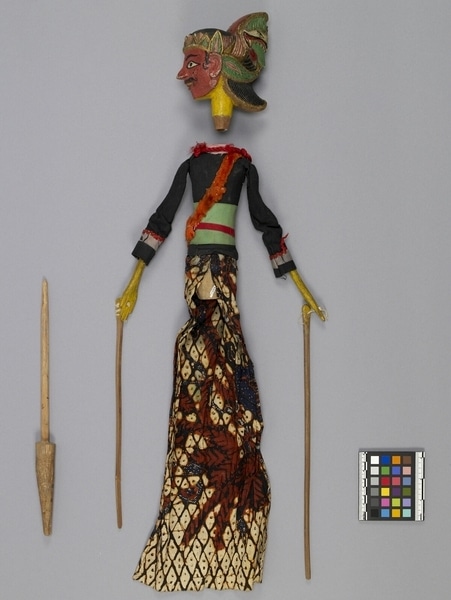Rod Puppet Item Number: Ib303 a-c from the MOA: University of British Columbia


Description
Three-dimensional male humanoid puppet: large head (part b) fits into body with skirt (part a), and a control rod (part c) with a long shaft passes through the body and fits into the neck of the figure's head. The body has jointed arms, each with a long controlling rod attached. The figure's face is glossy pink with black moustache, sideburns and caste mark. White eyeballs with black pupils; four gold teeth exposed. Yellow neck; black backswept hair outlined in gold. Light pink, green, red, and gold crowns; same colours repeated in elaborate headdress which rises at back to a form resembling a bird with a lolling green tongue. Upper row of jagged teeth . Figure wears black jacket, pink upright collar, edged with red on front; wide green band around waist, narrow red belt. Jacket sleeves have inserts above the cuffs decorated with red braid. Red cord at back of neck forming epaulettes. Orange shoulder sash; white vest, small yellow piece of fabric at neck line. Long batik skirt, coloured cream, brown and black. Hands yellow.
History Of Use
Javanese puppetry as an art form probably developed by the 11th century. The three-dimensional wooden wayang golek puppets of western Java, which are to be distinguished from the earlier and more sacred wayang kulit shadow plays puppets or other forms, appeared during the 16th century. Originally the plays depicted Javanese mythology, but after the Indian conquest of Java the Hindu epics, Ramayana and Mahabharata, were incorporated into the cycles, which comprise about 200 plays. An individual or group hires a dalang (puppet-master) to celebrate important occasions. The performances often last all night and are generally presented in three acts, with vocal and instrumental accompaniment. The individual plays vary widely in detail but usually involve conflict between good and evil. They serve a moral and religious purpose, and more recently, one of political commentary. Each puppet's character is represented by its appearance and placement onstage; protagonists with strong elements of good are placed to the right, antagonists of violent or evil nature to the left. This puppet's character suggests an honourable warrior and noble: it would be found onstage to the right, particularly in association with the Pandawa brothers in the Mahabharata cycle of plays, which are among the most commonly performed and favoured.
Cultural Context
Theatrical performance.
Iconographic Meaning
Many features of the puppet denotes a character of wealth, rank, and honour. Batik skirt shows membership in the nobility; headdress with Garuda Mungkur (mythical bird) a characteristic of nobles and gods. Refined features of face, lack of beard or other extensive facial hair, small eyes, mouth, and nose are typical of good characters of high ancestry. Lavish clothes also suggest wealth. Character puppet portrays is not known: possibly variations on the roles of Kresna or Karna, both honourable warriors who side with the Pandawa brothers in the Mahabharata cycle. They can be found in other cycles. Facing straight forward the puppet does not display particular reverence or modesty; the red (rose) colour of the face further suggest anger or violent dispositions, although in this case it may only represent passionate fury rather than evil nature.
Item History
- Made in Java, Indonesia
- Owned by Tradewind Antiques before March 15, 1983
- Received from Museum of Anthropology Shop Volunteers (Funding source) and Tradewind Antiques (Seller) on March 15, 1983
What
- Name
- Rod Puppet
- Identification Number
- Ib303 a-c
- Type of Item
- puppet
- Material
- wood, paint, cotton fibre, synthetic fibre ? and silk fibre ?
- Manufacturing Technique
- carved, painted, machine woven, machine stitched and hand stitched
- Part B
- height 14.0 cm, width 7.5 cm, depth 11.5 cm
- Part C
- height 30.5 cm, width 2.5 cm, depth 1.7 cm
- Part A
- height 53.5 cm, width 10.5 cm, depth 5.5 cm
Who
- Culture
- Sundanese
- Previous Owner
- Tradewind Antiques
- Received from
- Museum of Anthropology Shop Volunteers (Funding source) and Tradewind Antiques (Seller)
Where
- Holding Institution
- MOA: University of British Columbia
- Made in
- Java, Indonesia
When
- Ownership Date
- before March 15, 1983
- Acquisition Date
- on March 15, 1983
Other
- Condition
- fair
- Accession Number
- 0886/0037 a-c